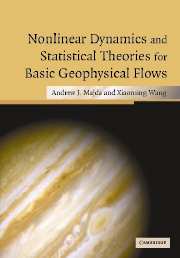Book contents
- Frontmatter
- Contents
- Preface
- 1 Barotropic geophysical flows and two-dimensional fluid flows: elementary introduction
- 2 The response to large-scale forcing
- 3 The selective decay principle for basic geophysical flows
- 4 Non-linear stability of steady geophysical flows
- 5 Topographic mean flow interaction, non-linear instability, and chaotic dynamics
- 6 Introduction to information theory and empirical statistical theory
- 7 Equilibrium statistical mechanics for systems of ordinary differential equations
- 8 Statistical mechanics for the truncated quasi-geostrophic equations
- 9 Empirical statistical theories for most probable states
- 10 Assessing the potential applicability of equilibrium statistical theories for geophysical flows: an overview
- 11 Predictions and comparison of equilibrium statistical theories
- 12 Equilibrium statistical theories and dynamical modeling of flows with forcing and dissipation
- 13 Predicting the jets and spots on Jupiter by equilibrium statistical mechanics
- 14 The statistical relevance of additional conserved quantities for truncated geophysical flows
- 15 A mathematical framework for quantifying predictability utilizing relative entropy
- 16 Barotropic quasi-geostrophic equations on the sphere
- Index
6 - Introduction to information theory and empirical statistical theory
Published online by Cambridge University Press: 30 November 2009
- Frontmatter
- Contents
- Preface
- 1 Barotropic geophysical flows and two-dimensional fluid flows: elementary introduction
- 2 The response to large-scale forcing
- 3 The selective decay principle for basic geophysical flows
- 4 Non-linear stability of steady geophysical flows
- 5 Topographic mean flow interaction, non-linear instability, and chaotic dynamics
- 6 Introduction to information theory and empirical statistical theory
- 7 Equilibrium statistical mechanics for systems of ordinary differential equations
- 8 Statistical mechanics for the truncated quasi-geostrophic equations
- 9 Empirical statistical theories for most probable states
- 10 Assessing the potential applicability of equilibrium statistical theories for geophysical flows: an overview
- 11 Predictions and comparison of equilibrium statistical theories
- 12 Equilibrium statistical theories and dynamical modeling of flows with forcing and dissipation
- 13 Predicting the jets and spots on Jupiter by equilibrium statistical mechanics
- 14 The statistical relevance of additional conserved quantities for truncated geophysical flows
- 15 A mathematical framework for quantifying predictability utilizing relative entropy
- 16 Barotropic quasi-geostrophic equations on the sphere
- Index
Summary
Introduction
In this chapter we will lay down the foundations for statistical theories of geophysical flows and predictability that will be developed in the following chapters. The mathematical underpinning for these applications is a systematic use of information theory following Shannon (1948) Shannon and Weaver (1949) and Jaynes (1957). We develop such ideas beginning with elementary examples in this chapter. The motivation for the statistical studies of barotropic quasi-geostrophic flows lies in the generic occurrence of coherent large-scale flow patterns in physical observations and numerical simulations of flows that are approximately two dimensional. Examples of these flows are large isolated eddies in the atmosphere (a well-known example is the great red spot in Jupiter's atmosphere, see Chapter 13), and the discovery of mesoscale eddies in the ocean. Large-scale organized flow patterns emerge under a wide variety of initial conditions of the flow and topography. The robustness of these patterns seems to indicate that these large-scale coherent flows do not depend on the fine details in the dynamics of the flow or the topography. In addition, these flow patterns persist for a long time, and are essentially steady in nature. Therefore, it is plausible that an explanation for the observed two-dimensional coherent patterns can be found with considerations from equilibrium statistical mechanics, where we are interested in the large-scale features of the flow rather than all the fine details, and where only a few bulk properties of the flow, such as averaged conserved quantities like the energy and enstrophy enter the analysis.
Information
- Type
- Chapter
- Information
- Publisher: Cambridge University PressPrint publication year: 2006
